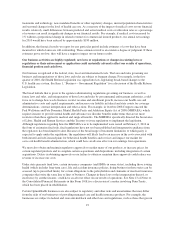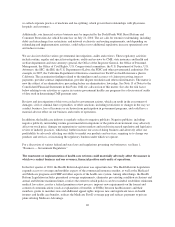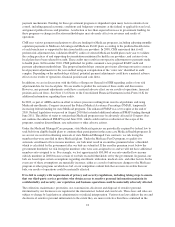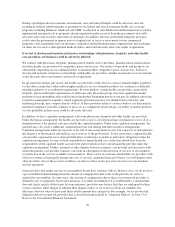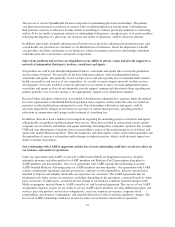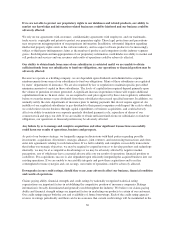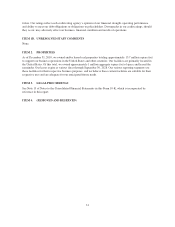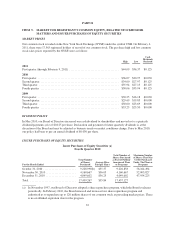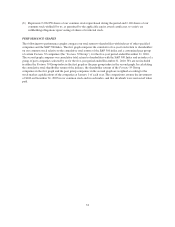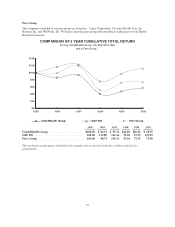United Healthcare 2010 Annual Report Download - page 30
Download and view the complete annual report
Please find page 30 of the 2010 United Healthcare annual report below. You can navigate through the pages in the report by either clicking on the pages listed below, or by using the keyword search tool below to find specific information within the annual report.Because of the nature of our business, we are routinely subject to various litigation actions, which, if
resolved unfavorably, could result in substantial penalties and/or monetary damages and adversely affect
our financial position, results of operations and cash flows.
Periodically, we become a party to the types of legal actions that can affect any business, such as employment
and employment discrimination-related suits, employee benefit claims, breach of contract actions, medical
malpractice, shareholder suits, and intellectual property-related litigation. In addition, because of the nature of
our business, we are routinely made party to a variety of legal actions related to the design and management of
our service offerings. These matters include, among others, claims related to health care benefits coverage and
payment (including disputes with enrollees, customers, and contracted and non-contracted physicians, hospitals
and other health care professionals), tort, contract disputes and claims related to disclosure of certain business
practices. We are also party to certain class action lawsuits brought by health care professional groups.
We are largely self-insured with regard to litigation risks. Although we maintain excess liability insurance with
outside insurance carriers for claims in excess of our self-insurance, certain types of damages, such as punitive
damages in some circumstances, are not covered by insurance. We record liabilities for our estimates of the
probable costs resulting from self-insured matters; however, it is possible that the level of actual losses will
exceed the liabilities recorded.
A description of significant legal actions in which we are currently involved is included in Note 13 of Notes to
the Consolidated Financial Statements. We cannot predict the outcome of these actions with certainty, and we are
incurring expenses in resolving these matters. Therefore, these legal actions could further increase our cost of
doing business and adversely affect our financial position, results of operations and cash flows.
Our investment portfolio may suffer losses, which could materially adversely affect our results of
operations.
Market fluctuations could impair our profitability and capital position. Volatility in interest rates affects our
interest income and the market value of our investments in debt securities of varying maturities, which comprise
the vast majority of the fair value of our investments as of December 31, 2010. Relatively low interest rates on
investments, such as those experienced during recent years, have negatively impacted our investment income,
and a prolonged low interest rate environment could further adversely affect our investment income. In addition,
defaults by issuers, primarily from investments in liquid corporate and municipal bonds, who fail to pay or
perform on their obligations, could reduce our net investment income as we may be required to write down the
value of our investments, which would adversely affect our profitability and shareholders’ equity.
We also allocate a small proportion of our portfolio to equity investments, which are subject to greater volatility
than fixed income investments. General economic conditions, stock market conditions, and many other factors
beyond our control can adversely affect the value of our equity investments and may result in investment losses.
There can be no assurance that our investments will produce total positive returns or that we will not sell
investments at prices that are less than their carrying values. Changes in the value of our investment assets, as a
result of interest rate fluctuations, illiquidity or otherwise, could have a negative effect on our shareholders’
equity. In addition, if it became necessary for us to liquidate our investment portfolio on an accelerated basis, it
could have an adverse effect on our results of operations and the capital position of regulated subsidiaries.
If the value of our intangible assets is materially impaired, our results of operations, shareholders’ equity
and debt ratings could be materially adversely affected.
Goodwill and other intangible assets were $25.7 billion as of December 31, 2010, representing 41% of our total
assets. We periodically evaluate our goodwill and other intangible assets to determine whether all or a portion of
their carrying values may be impaired, in which case a charge to earnings may be necessary. For example, the
28



